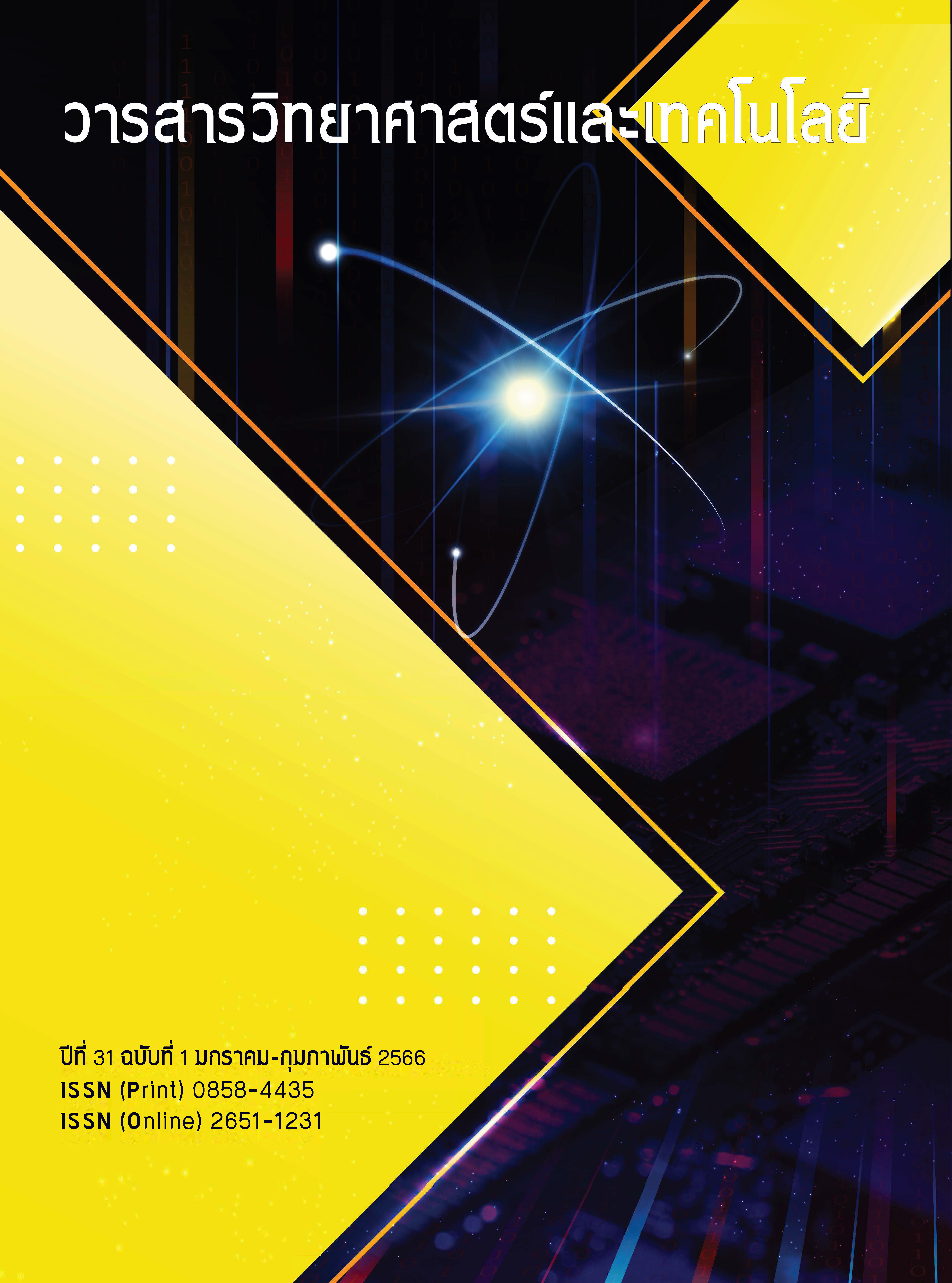Secondary Metabolite Contents in Shoot Cultures of Holy Basil Purple Type (Ocimum sanctum L.)
Main Article Content
Abstract
Holy basil purple type (Ocimum sanctum L.) is a medicinal plant commonly used for medicinal purposes. This study aimed to investigate the secondary metabolite contents in shoot cultures of holy basil purple type. Secondary metabolite contents and radical scavenging activities of 3 to 6-week-old shoots cultured on Murashige and Skoog (MS) medium supplemented with 0.5 mg/L 6-benzyladenine (BA) were determined and compared with those of mother plant and transplantation plant grown under in vivo conditions. The results showed that the regenerated shoots had higher total phenolic and flavonoid contents, and radical scavenging activities than in vivo leaves. The greatest of total phenolic (152.10±7.94 mg GAE/g dry extract), total flavonoid contents (122.04±3.66 mg CE/g dry extract), and radical scavenging activity (EC50 of 12.95±1.37 μg/ml) were observed in 5-week-old regenerated shoots. However, the eugenol contents from leaves of mother plant l (2,931.17±286.61 μg/g dry extract) and transplantation plant (8,816.18±510.60 μg/g dry extract) were higher than in vitro regenerated shoots.
Article Details
References
Mondal S., Miranda, B. R. and Mahapatra, S. C., 2009, The science behind sacredness of tulsi (Ocimum sanctum Linn.), Ind. J. of Physiol. Pharmacol. 53: 291-306.
Singh, E., Sharma, S., Dwivedi, J. and Sharma, S., 2012, Diversified potentials of Ocimum sanctum Linn (Tulsi): An exhaustive survey, J. Nat. Prod. Plant Resource. 2: 39-48.
Jadhav, B. K., Khaandelwal, K. R., Ketakr, A. R. and Pisal, S. S., 2004, Formulation and evaluation of mucoadhesive tablets containing eugenol for treatment of periodontal diseases, Drug dev. Ind. Pharma. 30: 195-203.
Prakash, P. and Gupta, N., 2005, Therapeutic uses of Ocimum sanctum Linn (tulsi) with a note on eugenol and its pharmacological actions: a short review, Indian J. Physiol. Pharmacol. 49: 125-131.
Świzdor, A., Panek, A., Milecka-Tronina, N. and Kolek, T., 2012, Biotransformations utilizing beta-oxidation cycle reactions in the synthesis of natural compounds and medicines, Int. J. Mol. Sci. 13: 16514-16543.
Smetanska, I., 2008, Production of secondary metabolites using plant cell cultures, Adv. Biochem. Eng. Biotechnol. 111: 187-228.
Autaijamsripon, J., Jirakiattikul, Y., Rithichai, P. and Itharat, A., 2018, Effect of plant growth regulators on shoot multiplication and root induction of Ocimum sanctum L. (holy basil purple type) under aseptic conditions, Thai Journal of Science and Technology 27: 630-638. (in thai)
Yotchart, Y., Kerdchoechuen, O. Laohakunjit, N. and Matta, F. B., 2015, Effect of plant growth regulators and volatile compounds synthesis in holy basil (Ocimum sanctum L. cv. Dang), Agricultural Sci. J. 46: 189-192. (in thai)
Bhuvaneshwari, K., Gokulanathan, A., Jayanthi, M., Govindasamy, V., Milella, L., Lee, S., Yang, D. C. and Girija, S., 2016, Can Ocimum basilicum L. and Ocimum tenuiflorum L. in vitro culture be a potential source of secondary metabolites?, Food Chem. 194: 55-60.
Mohan, N., Jassal P. S., Kumar, V. and Singh, R. P., 2011, Comparative in vitro and in vivo study of antioxidants and phytochemical content in Bacopa monnieri, Recent Res. Sci. Technol. 3: 78-83.
Esmaeili, A. K., Taha, R. M., Mohajer, S. and Banisalam, B., 2016, In vitro regeneration and comparison of phenolic content, antioxidant and antityrosinase activity of in vivo and in vitro grown Asparagus officinalis, Sains Malays. 45: 373–381
Schmeda-Hirschmann, G., Jordan, M., Gerth, A., and Wilken, D., 2005, Secondary metabolite content in rhizomes, callus cultures and in vitro regenerated plantlets of Solidago chilensis, Zeitschrift fur Naturforschung C. 60: 5-10.
Szopa, A., Kokotkiewicz, A., Bednarz, M., Luczkiewicz, M. and Ekiert, H., 2017, Studies on the accumulation of phenolic acids and flavonoids in different in vitro culture systems of Schisandra chinensis (Turcz.) Baill. using a DAD-HPLC method, Phytochem Lett. 20: 462-469.
Wang, J., Qian, J., Yao, L. and Lu, Y., 2015, Enhanced production of flavonoids by methyl jasmonate elicitation in cell suspension culture of Hypericum perforatum, Bioresour. Bioprocess. 2: 1-9.
Smetanska, I., 2008, Production of secondary metabolites using plant cell cultures, Adv. Biochem. Eng. Biotechnol. 111: 187-228.
Sharma, V., Wani, S. R. and Chaudhary, P., 2016, Precursor mediated enhanced eugenol production in Ocimum sanctum L. through tissue culture methodologies and quantitative estimation through HPLC, J. Essent. Oil Bear. Pl. 19: 241-246.
Inam, F., Deo, S. and Narkhede, N., 2014, HPLC –UV method development and quantification of eugenol from methanolic extracts of some spices, J. Chem. Biol. Phys. Sci. 3: 96-102.
Phaisitsakulnat, N., Jirakiattikul, Y. and Rithichai, P., 2021, Effects of methyl jasmonate and salicylic acid on antioxidant contents in callus cultures of holy basil purple type, Thai Science and Technology Journal 29: 641-652. (in thai)
Banthorpe, B. V., 1994, Secondary metabolism in plant tissue culture: Scope and limitations, Nat. Prod. Rep. 11: 303-328.
Mohammadi N., S., Özgüneş, H. and Başaran, N., 2017, Pharmacological and toxicological properties of eugenol, Turk. J. Pharm. Sci. 14: 201-206.
Mahajan, N., Singh, J. and Sinha, S., 2014, Comparison of total flavonoid, phenolic content and antioxidant capacity in leaf and seed extracts from white holy basil (Ocimum sanctum), Int. J. Appl. Biol. Pharm. 5: 34-42.
Srivastava, M. P., Tiwari, R. and Sharma, N., 2013, Assessment of phenol and flavonoid content in the plant materials, J. New Biol. Reports 2: 163-166.
Thiruvengadam, M. and Chung, I. M., 2015, Phenolic compound production and biological activities from in vitro regenerated plants of gherkin (Cucumis anguria L.), Electron. J. Biotechnol. 18: 295-301.
Figueiró, A. D. A., Correa, C. M., Astarita, L. V. and Santarém, E. R., 2010, Long-term maintenance of in vitro cultures affects growth and secondary metabolism of St. John’s Wort, Cienc. Rural. 40: 2115-2121.
Danaee, M., Farzinebrahimi, R., Kadir, M. A., Sinniah, U. R., Mohamad, R. and Taha, R. M., 2015, Effects of MeJA and SA elicitation on secondary metabolic activity, antioxidant content and callogenesis in Phyllanthus pulcher, Braz. J. Bot. 38: 265–272.


